Events of Saturday morning, 8th November 2014
Each of our apartments had an outside balcony provided with table and chairs but, curiously, both were protected by high walls offering only views of the sky. My sitting room also had a tiny balcony situated at the rear corner of the hotel, giving views of the pedestrianised Kartnerstrasse. This is a major shopping area lined with designer stores and the (now obligatory) fast food outlets like McDonalds. Early on Saturday morning, there were few pedestrians as yet but, instead, a number of lorries were delivering new stock to the various retailers.
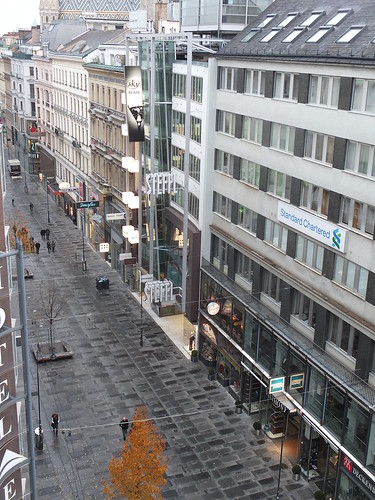 Kartnerstrasse viewed from my balcony.
Kartnerstrasse viewed from my balcony.
Glimpses of various landmarks were also visible from the balcony with St. Stephen's Cathedral, which the Viennese affectionately call "the Steffl" dominating the scene. St. Stephen's was first recorded in the 13th century but the 174m-tall south tower was started in 1359, taking 74 years to complete.
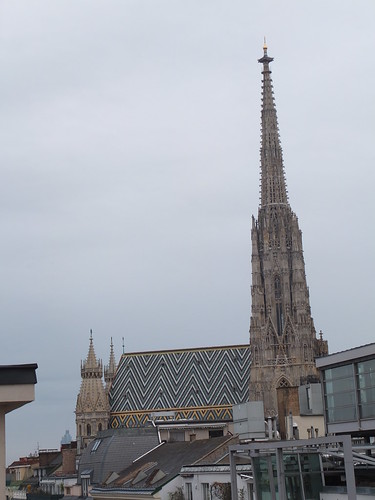
St. Stephen's Cathedral viewed from my balcony.
The hotel offered an excellent buffet breakfast in the restaurant. In addition to the main restaurant, there is a modern all-glass extension they call the Wintergarden, offering views of the Neuer Markt and the city waking up.
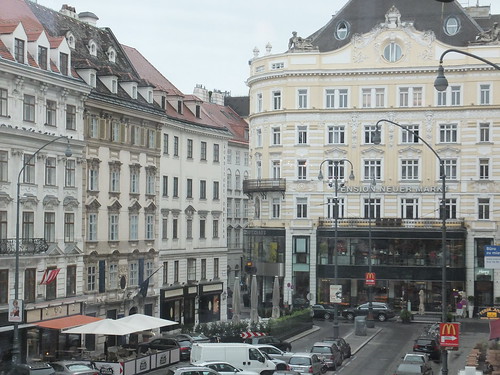 View of the Neuer Markt from the Wintergarden at the Ambassador. Note the red street signs directing pedestrians to McDonalds.
View of the Neuer Markt from the Wintergarden at the Ambassador. Note the red street signs directing pedestrians to McDonalds.
My friend Rita was also keen to visit the Spanish Riding School which claims "The Spanish Riding School in Vienna is the only institution in the world which has practiced for nearly 450 years and continues to cultivate classical equitation in the Renaissance tradition of the haute école. The objective of classical equitation is to study the way the horse naturally moves and to cultivate the highest levels of haute école elegance the horse is capable of through systematic training. The result creates an unparalleled harmony between rider and horse, as only Vienna's Spanish Riding School achieves". Various public performances are given but we found that these were already fully booked for days ahead. However, admission to the morning training sessions does not require pre-booking so we obtained directions from the hotel and decided that we would walk there. We threaded our way through the tangle of narrow streets approaching the Hofburg - a complex of buildings built in different periods which served the Habsburg Dynasty for over 600 years. Having passed St. Augustine's Church, we entered Josefplatz Square with its equestrian statue of Emperor Josef II. The Square is flanked by the Redouten Halls and the Grand Hall, with an entrance to the National Library.
 Josefplatz Square.
Josefplatz Square.
We were surprised to encounter a group of the famous Lipizzaner horses being led by uniformed grooms from right to left across the street we were on, the Reitschulgasse. The horses had emerged from a courtyard on the right which was clearly the stables. Only later did I discover that the Stallburg Wing containing the stables is part of the 16th century Imperial Palace built by Emperor Ferdinand I. A few years ago, the inner courtyard was provided with a moveable roof, allowing the space to be hired out for dinners or other functions. You can read more about the Stallburg here.
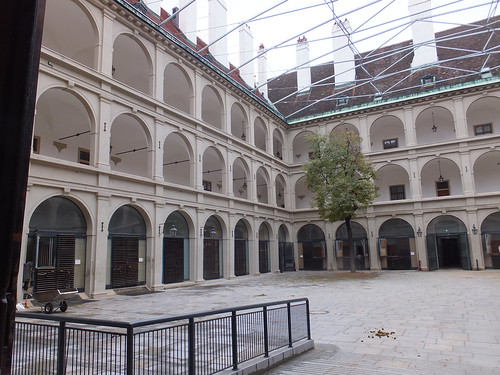 The Stallburg. Note the framework over the inner courtyard to support the removeable roof. A groom will presumably be along shortly to use the equipment on the left to remove the horse droppings on the right.
The Stallburg. Note the framework over the inner courtyard to support the removeable roof. A groom will presumably be along shortly to use the equipment on the left to remove the horse droppings on the right.
St. Michael's Square was being set up for a function I didn't work out with various temporary stages and sound systems. The impressive curved facade of St. Michael's Wing on our left was built in 1888, implementing a plan originally proposed in 1726. St. Michael's Gate in this facade leads to the Imperial Silverware Collection, the Imperial Apartments and the Empress Elisabeth Museum (usually called the 'Sisi Museum'). A smaller gateway leads to the Spanish Riding School.
 The facade of St. Michael's Wing.
The facade of St. Michael's Wing.
A modern box office was rapidly issuing tickets for the morning training session which was already in progress. The training takes place in the Winter Riding School. This is a large, fairly grand rectangular building, illuminated by three large chandeliers. There is a sand-covered area at ground level for the horses and riders. All four sides are flanked by galleries at low level and high level and both sets of galleries were full. We only obtained seats because a young family insisted on giving up their seats.
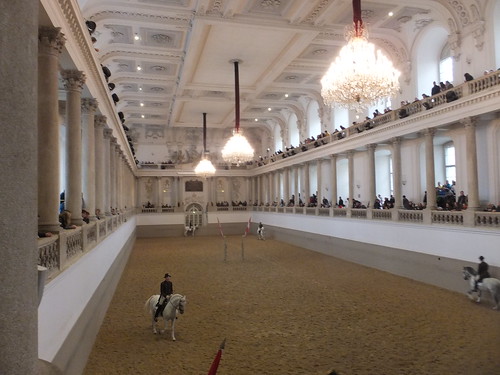 The Winter Riding School.
The Winter Riding School.
Five horses were being exercised to music played over a system of loudspeakers. There were four male riders and one lady, all dressed in bicorn hats and riding coats. At the end of that training session, the horses were lined up, the riders dismounted and five grooms appeared, placed a bridle on each horse and led them back to the stables. Presently, another set of horses were brought in, the riders re-appeared and another session started. Training horses to the necessary standard takes place over a period of years. I noticed what I took to be the Riding Master watching from seats at ground level. He was similarly attired to the riders, with the addition of a greatcoat. A couple of times, he signalled to the lady rider and stood up to discuss some point with her. Later, he called over one of the male riders. Once again, the riders lined up, dismounted and grooms took the horses away. For the final period, six horses were brought in and a voice over the loudspeakers announced that the school's latest rider would be taking part. This proved to be another lady but, presumably because she is not yet deemed fully qualified, rather than wearing the bicorn hat and riding coat, she was in groom's uniform. Another training session took place, this time with six horses criss-crossing the arena at varying speeds. When this last group of horses had finished and been led back to the stables, the spectators made their way out to the cafe and souvenir shop.
Rita and I had a snack in the cafe and became involved in conversation with three middle-aged Dutch gentlemen. The one man was an arable farmer and, unprompted, he announced that he was firmly in favour of the European Union with its common currency and freedom of movement. Whilst professing fondness for the English, he felt that there was no room for 'semi-detached' members and that the UK should 'shape up or ship out'. Rita made some puchases in the well-stocked souvenir shop.
In St. Michael's Square, there were a number of the four-wheeled horse-drawn carriages which the French call 'fiacre' but in Vienna are called 'fiaker'. There's a little history on Wikipedia here. However, we decided to walk back to our hotel for a 'breather' before taking a bus tour of the city in the afternoon.
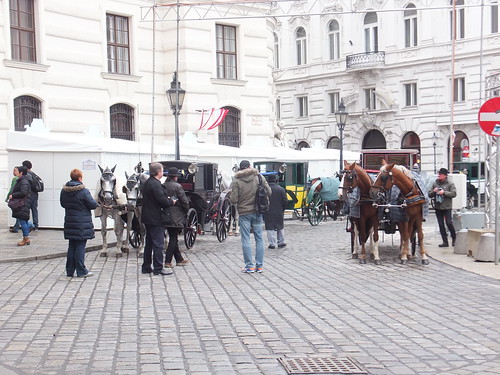 Fiaker plying for hire in St. Michael's Square.
Fiaker plying for hire in St. Michael's Square.
Related posts on this website
A Weekend in Vienna (Part 1).
A Weekend in Vienna (Part 3).
A Weekend in Vienna (Part 4).
A Weekend in Vienna (Part 5).
Books
[1] 'Imperial Vienna' by Lina Schnorr, published by H.B. Medienvertrieb GesmbH (ISBN: 978-3-9502396-9-0).
[2] 'Vienna: Art and Architecture', by various authors, published by h.f. ullmann (ISBN 978-3-8331-6006-6).
My Pictures
The albums below relate to this post:-
Ambassador Hotel, Wien.
Wien, Austria.
The collection below includes all the albums on the Vienna trip:-
Austria.
